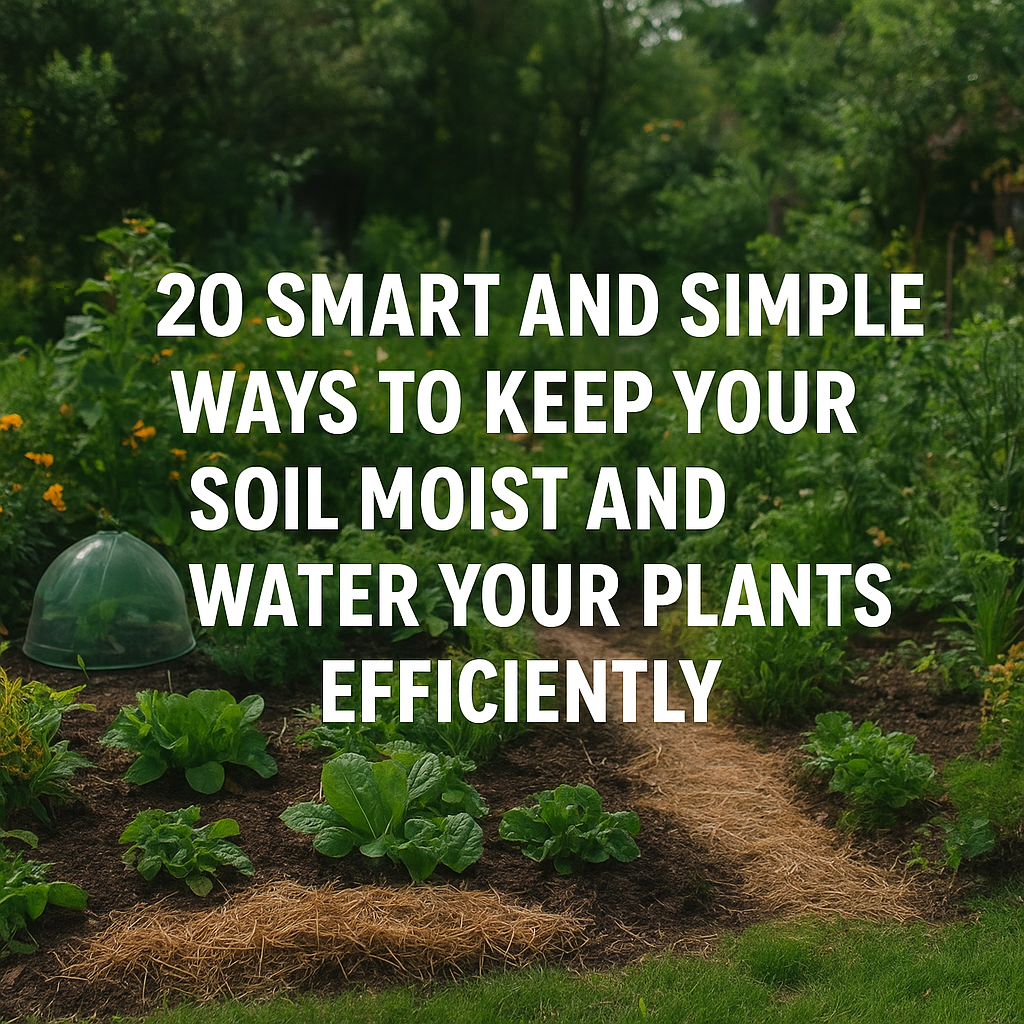Keeping your garden hydrated can sometimes feel like a full-time job, especially during hot, dry spells. Fortunately, there are plenty of clever techniques that make watering easier, reduce waste, and help your plants thrive. From using natural mulches and self-watering pots to clever DIY tricks like plastic bottle drippers, these 20 methods will help your garden stay lush and healthy with less effort. Whether you’re a seasoned gardener or just starting out, these tips are practical, effective, and easy to incorporate into your daily routine.
1. Mulching with Grass Clippings
After mowing your lawn, don’t toss those clippings—use them! Spread a thin layer around your plants to help the soil hold onto moisture and keep roots cool. Over time, the clippings break down, feeding your garden naturally. I like to toss mine around my tomatoes; it feels like giving them a cozy little blanket.
2. Adding Water-Storing Crystals
These little crystals are like tiny water banks for your plants. Mix them into potting soil before planting, and they’ll absorb extra water, releasing it slowly to the roots. I once forgot to water my indoor herbs for a few days, and thanks to these crystals, they didn’t even notice.
3. Using Terracotta Water Spikes
Fill a plastic bottle with water and attach it to a terracotta spike in the soil. The clay slowly drips water into the roots over time, keeping plants hydrated without daily attention. It’s perfect for busy weeks—I use this trick for my potted basil on the balcony.
4. Applying a Layer of Compost
A layer of compost on top of your soil isn’t just food for your plants—it locks in moisture and prevents that hard, cracked surface after the sun hits. I love doing this around my peppers; the soil stays soft and damp, and the plants always look happier.
5. Reusing Coffee Grounds
Don’t pour used coffee down the drain—mix it into your garden soil! Coffee grounds improve texture, help retain moisture, and slowly release nutrients. I sprinkle some around my rose bushes every couple of weeks; they seem to perk up and bloom more vigorously.
6. Planting in Self-Watering Pots
Self-watering pots are a gardener’s lifesaver, especially for busy weeks. The reservoir at the bottom supplies water steadily, so plants drink only what they need. I have a few herbs in these pots on my kitchen windowsill—they barely ask for attention, yet they stay lush and green.
7. Setting Up a Drip Irrigation System
A drip system delivers water directly to the roots, drop by drop. It saves water and keeps leaves dry, reducing disease risk. I installed one along my veggie patch last summer, and it was amazing to see everything thrive with minimal effort.
8. Burying Clay Pots (Ollas)
Ollas are unglazed clay pots that you bury in the soil and fill with water. The water seeps slowly through the walls, keeping roots hydrated for days. I started using one for my tomato bed, and it felt like giving my plants a secret underground fountain.
9. Covering Soil with Straw Mulch
Straw is like sunscreen for your garden soil. Spread it around plants to slow evaporation, cool the ground, and protect tender roots. My pumpkin patch loves it—plus, it gives a nice rustic look to the garden.
10. Grouping Thirsty Plants Together
Keep plants with similar water needs in the same spot. It makes watering simpler and ensures each plant gets just the right amount. I cluster my basil, parsley, and chives together; it’s so much easier than guessing who’s thirsty each day.
11. Using Shade Cloth in Hot Weather
A light shade cloth can save your plants from scorching sun and rapid soil drying. Draped over beds during peak heat, it slows evaporation and keeps sensitive plants comfortable. I use one over my lettuce patch in midsummer, and it’s like giving them a little cool retreat.
12. Watering Plants in the Early Morning
Watering before the sun rises is a simple trick with big results. Cool soil holds moisture longer, and plants absorb it efficiently. I always water my tomatoes at dawn—it feels peaceful, and I know the water isn’t just disappearing into the air.
13. Lining Hanging Baskets with Moss
Line hanging baskets with sphagnum moss before adding soil. The moss retains water while letting excess drain away, keeping roots happy. My ferns in hanging baskets never dry out now, and they look fuller than ever.
14. Installing a Soaker Hose
A soaker hose delivers water right to the soil surface, where roots can drink it slowly. It reduces waste and keeps plants consistently hydrated. I laid one along my vegetable bed last season, and it was like giving every plant its own personal faucet.
15. Creating a Pebble Tray for Pots
Set pots on trays filled with water and pebbles. As the water evaporates, it raises humidity around the plant and slows soil drying. My orchids thrive this way, and I barely need to water them as often.
16. Collecting Rainwater in Barrels
Place rain barrels under downspouts to catch natural rainfall. It’s an eco-friendly way to water your garden with soft, chlorine-free water. I keep one near my vegetable patch, and it feels great knowing I’m using nature’s own irrigation.
17. Adding a Layer of Coconut Coir
Mix coconut coir into your potting soil for excellent water retention while keeping soil airy. I like to use it for my indoor potted plants; they stay hydrated longer without feeling soggy.
18. Planting Ground Covers
Low-spreading ground covers shade the soil, slow evaporation, and enrich the earth as they grow. I planted creeping thyme around my flower beds—it keeps weeds down and the soil pleasantly moist.
19. Using Plastic Bottle Drippers
Take a plastic bottle, poke small holes in the cap, and bury it upside down near roots. Water seeps out slowly, hydrating plants efficiently. I did this for my balcony herbs during a heatwave, and they barely noticed the dry spell.
20. Creating Windbreaks with Fences or Shrubs
Set up fences or plant shrubs to shield your garden from wind. Less wind means less soil moisture lost and happier plants. I planted a small row of junipers around my young seedlings last year, and the difference was immediately noticeable—they stayed lush while other areas dried out quickly.
By combining these techniques, you can create a garden that’s resilient, water-efficient, and low-maintenance. Small changes—like mulching, setting up drip irrigation, or collecting rainwater—add up to healthier plants, richer soil, and less worry about watering schedules. Experiment with the methods that suit your space and lifestyle, and enjoy the satisfaction of a thriving, well-watered garden all season long.


